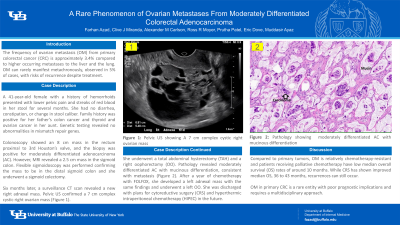Monday Poster Session
Category: Colon
P1724 - A Rare Phenomenon of Ovarian Metastases From Moderately Differentiated Colorectal Adenocarcinoma
Monday, October 23, 2023
10:30 AM - 4:15 PM PT
Location: Exhibit Hall

Has Audio

Farhan Azad, DO
University at Buffalo
Buffalo, New York
Presenting Author(s)
Farhan Azad, DO, Clive J. Miranda, DO, MS, Alexander M. Carlson, DO, Ross R. Moyer, DO, Prutha Patel, DO, Eric J. Dove, MD, Muddasir Ayaz, MD
University at Buffalo, Buffalo, NY
Introduction: The frequency of ovarian metastasis (OM) from primary colorectal cancer (CRC) is approximately 3.4% compared to higher occurring metastases to the liver and the lung. OM can rarely manifest metachronously, observed in 5% of cases, with risks of recurrence despite treatment.
Case Description/Methods: A 41-year-old female with a history of hemorrhoids presented with lower pelvic pain and intermittent streaks of red blood in her stool for several months. She denied any diarrhea, constipation, or change in stool caliber. Family history was significant for colon cancer in her father and both thyroid and ovarian cancer in her aunt. Genetic testing revealed no abnormalities in mismatch repair genes. Vital signs and laboratory values were unremarkable, with hemoglobin stable at 13.4 g/dL. Colonoscopy revealed an infiltrative, non-obstructive, partially circumferential 8 cm mass in the rectum proximal to 3rd Houston’s valve. Biopsy was positive for moderately differentiated invasive adenocarcinoma. However, MRI revealed a 2.5 cm mass within the sigmoid colon. Given the discrepancy, a flexible sigmoidoscopy was performed which revealed a normal mucosa up to the rectosigmoid and confirmed the mass to be in the distal sigmoid colon. The patient underwent a sigmoid colectomy and was discharged. Six months later, a surveillance CT scan revealed a new right adnexal mass suspicious of an ovarian cyst. Pelvic US confirmed a 7 cm complex cystic right ovarian mass (Figure 1). The patient underwent a total abdominal hysterectomy (TAH) and a right oophorectomy. Pathology revealed moderately differentiated adenocarcinoma with mucinous differentiation, consistent with metastasis from colorectal adenocarcinoma (Figure 2). She started adjuvant chemotherapy with leucovorin, fluorouracil, and oxaliplatin (FOLFOX) as an outpatient. One year later, she developed a metastatic left adnexal complex cyst and underwent a left oophorectomy, with pathology showing the same findings as previously. She was discharged with plans for future discussion of cytoreductive surgery (CRS) and hyperthermic intraperitoneal chemotherapy (HIPEC) as a therapy option.
Discussion: Compared to primary tumors, OM is relatively chemoresistant and patients receiving palliative chemotherapy have low median overall survival (OS) rates of around 10 months. While CRS has shown improved median OS, 36 to 43 months, recurrences can still occur. OM in primary CRC is a rare entity with poor prognostic implications and requires a multidisciplinary approach.

Disclosures:
Farhan Azad, DO, Clive J. Miranda, DO, MS, Alexander M. Carlson, DO, Ross R. Moyer, DO, Prutha Patel, DO, Eric J. Dove, MD, Muddasir Ayaz, MD. P1724 - A Rare Phenomenon of Ovarian Metastases From Moderately Differentiated Colorectal Adenocarcinoma, ACG 2023 Annual Scientific Meeting Abstracts. Vancouver, BC, Canada: American College of Gastroenterology.
University at Buffalo, Buffalo, NY
Introduction: The frequency of ovarian metastasis (OM) from primary colorectal cancer (CRC) is approximately 3.4% compared to higher occurring metastases to the liver and the lung. OM can rarely manifest metachronously, observed in 5% of cases, with risks of recurrence despite treatment.
Case Description/Methods: A 41-year-old female with a history of hemorrhoids presented with lower pelvic pain and intermittent streaks of red blood in her stool for several months. She denied any diarrhea, constipation, or change in stool caliber. Family history was significant for colon cancer in her father and both thyroid and ovarian cancer in her aunt. Genetic testing revealed no abnormalities in mismatch repair genes. Vital signs and laboratory values were unremarkable, with hemoglobin stable at 13.4 g/dL. Colonoscopy revealed an infiltrative, non-obstructive, partially circumferential 8 cm mass in the rectum proximal to 3rd Houston’s valve. Biopsy was positive for moderately differentiated invasive adenocarcinoma. However, MRI revealed a 2.5 cm mass within the sigmoid colon. Given the discrepancy, a flexible sigmoidoscopy was performed which revealed a normal mucosa up to the rectosigmoid and confirmed the mass to be in the distal sigmoid colon. The patient underwent a sigmoid colectomy and was discharged. Six months later, a surveillance CT scan revealed a new right adnexal mass suspicious of an ovarian cyst. Pelvic US confirmed a 7 cm complex cystic right ovarian mass (Figure 1). The patient underwent a total abdominal hysterectomy (TAH) and a right oophorectomy. Pathology revealed moderately differentiated adenocarcinoma with mucinous differentiation, consistent with metastasis from colorectal adenocarcinoma (Figure 2). She started adjuvant chemotherapy with leucovorin, fluorouracil, and oxaliplatin (FOLFOX) as an outpatient. One year later, she developed a metastatic left adnexal complex cyst and underwent a left oophorectomy, with pathology showing the same findings as previously. She was discharged with plans for future discussion of cytoreductive surgery (CRS) and hyperthermic intraperitoneal chemotherapy (HIPEC) as a therapy option.
Discussion: Compared to primary tumors, OM is relatively chemoresistant and patients receiving palliative chemotherapy have low median overall survival (OS) rates of around 10 months. While CRS has shown improved median OS, 36 to 43 months, recurrences can still occur. OM in primary CRC is a rare entity with poor prognostic implications and requires a multidisciplinary approach.

Figure: Figure 1:Pelvic US showing a 7 cm complex cystic right ovarian mass
Figure 2: Pathology showing moderately differentiated adenocarcinoma with mucinous differentiation, consistent with metastasis from colorectal adenocarcinoma
Figure 2: Pathology showing moderately differentiated adenocarcinoma with mucinous differentiation, consistent with metastasis from colorectal adenocarcinoma
Disclosures:
Farhan Azad indicated no relevant financial relationships.
Clive Miranda indicated no relevant financial relationships.
Alexander Carlson indicated no relevant financial relationships.
Ross Moyer indicated no relevant financial relationships.
Prutha Patel indicated no relevant financial relationships.
Eric Dove indicated no relevant financial relationships.
Muddasir Ayaz indicated no relevant financial relationships.
Farhan Azad, DO, Clive J. Miranda, DO, MS, Alexander M. Carlson, DO, Ross R. Moyer, DO, Prutha Patel, DO, Eric J. Dove, MD, Muddasir Ayaz, MD. P1724 - A Rare Phenomenon of Ovarian Metastases From Moderately Differentiated Colorectal Adenocarcinoma, ACG 2023 Annual Scientific Meeting Abstracts. Vancouver, BC, Canada: American College of Gastroenterology.
